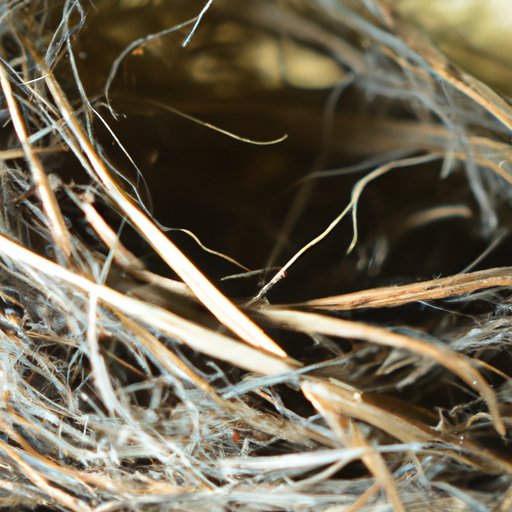Introduction
A bird’s nest is a structure built by birds to provide a safe place for them to lay and incubate their eggs. These nests are made from a variety of materials, including twigs, leaves, feathers, grasses, moss, mud, and other items. The purpose of this article is to explore the materials used to build a bird’s nest, the types of nests constructed by birds, the steps involved in building a bird nest, how weather and climate affect nest construction, how a bird’s nest helps it survive, the differences in nest building among different species of birds, and the role of human activity on nest building habits.
Materials Used to Build a Bird’s Nest
Birds use a variety of materials to build their nests. Common materials include twigs, straw, grasses, moss, lichens, feathers, fur, and hair. Some birds even use snakeskin, spider webs, and insect cocoons. Other unique materials such as plastic bags, paper, string, and cigarette butts have been found in nests as well.
Types of Nests Constructed by Birds
Birds construct two main types of nests: open nests and closed nests. Open nests are shallow cups that are usually lined with soft materials such as feathers or fur. Closed nests are more complex structures typically built with an outer layer of sticks and an inner layer of softer material. These nests tend to be more secure than open nests.

Steps Involved in Building a Bird Nest
The process of building a bird’s nest can involve several steps. First, the bird will collect materials from its environment such as twigs, straw, grasses, moss, lichens, feathers, fur, and hair. Next, the bird will assemble the nest by weaving the items together to form a cup-like shape. After the nest is assembled, the bird may decorate it with additional materials such as moss, lichens, and feathers. Finally, the bird will secure the nest to its chosen location such as a tree branch or rock ledge.

How Weather and Climate Affect Nest Construction
Weather and climate can have a significant impact on the nest building process. Cold temperatures can make it difficult for birds to collect materials and assemble the nest. Windy conditions can cause the nest to become unstable and easily blown away. Heavy rainfall can damage the nest or wash away the materials used to build it.
How a Bird’s Nest Helps It Survive
A bird’s nest provides several benefits that help birds survive in the wild. The nest provides protection from predators by providing a safe space for the bird to lay its eggs. It also serves as a hiding spot for the bird’s eggs and young. Finally, the nest can provide insulation from cold temperatures.
Nest Building Among Different Species of Birds
Different species of birds construct their nests in unique ways. For example, some species of birds such as hummingbirds build cup-shaped nests while others such as woodpeckers construct dome-shaped nests. There can also be differences in where the birds build their nests. Some birds prefer to build their nests in trees while others may build their nests on the ground or in rock crevices.

The Role of Human Activity on Nest Building Habits
Human activity can have a profound effect on the nesting habits of birds. Disturbance from humans can cause birds to abandon their nests. Deforestation, the cutting down of trees, can reduce the number of suitable nesting sites available to birds. Pollution can also contaminate the materials used to build a bird’s nest.
Conclusion
Building a bird’s nest is a complex process that requires a variety of materials and environmental conditions. Different species of birds construct their nests in unique ways and the impact of human activity can have a major effect on the nesting habits of birds. Understanding the process of nest building can help us better appreciate the beauty of nature and the importance of preserving our natural environment.
(Note: Is this article not meeting your expectations? Do you have knowledge or insights to share? Unlock new opportunities and expand your reach by joining our authors team. Click Registration to join us and share your expertise with our readers.)
